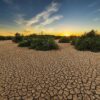As the world heats up due to climate change, how much can we continue to depend on plants and soils to help alleviate some of our self-inflicted damage by removing carbon pollution from the atmosphere?
New work led by Carnegie’s Wu Sun and Anna Michalak tackles this key question by deploying a bold new approach for inferring the temperature sensitivity of ecosystem respiration—which represents one side of the equation balancing carbon dioxide uptake and carbon dioxide output in terrestrial environments. Their findings are published in Nature Ecology & Evolution.
“Right now, plants in the terrestrial biosphere perform a ‘free service’ to us, by taking between a quarter and a third of humanity’s carbon emissions out of the atmosphere,” Michalak explained. “As the world warms, will they be able to keep up this rate of carbon dioxide removal? Answering this is critical for understanding the future of our climate and devising sound climate mitigation and adaptation strategies.”
Photosynthesis, the process by which plants, algae, and some bacteria convert the Sun’s energy into sugars for food, requires the uptake of atmospheric carbon dioxide. This occurs during daylight hours. But through day and night, these same organisms also perform respiration, just like us, “breathing” out carbon dioxide.
Being able to better quantify the balance of these two processes across all the components of land-based ecosystems—from soil microbes to trees and everything in between—and to understand their sensitivity to warming, will improve scientists’ models for climate change scenarios.
In recent years, researchers—including Carnegie’s Joe Berry—have developed groundbreaking approaches for measuring the amount of carbon dioxide taken up by plants through photosynthesis, such as using satellites to monitor global photosynthetic activity and measuring the concentration of the atmospheric trace gas carbonyl sulfide.
But, until now, developing similar tools to track respiration at the scale of entire biomes or continents has not been possible. As a result, respiration is often indirectly estimated as the difference between photosynthesis and the overall uptake of carbon dioxide.
“We set out to develop a new way to infer how respiration is affected by changes in temperature over various ecosystems in North America,” said Sun. “This is absolutely crucial for refining our climate change projections and for informing mitigation strategies.”
Michalak, Sun, and their colleagues developed a new way to infer at large scales how much respiration increases when temperatures warm using measurements of atmospheric carbon dioxide concentrations. These measurements were taken by a network of dozens of monitoring stations across North America.
The team revealed that atmospheric observations suggest lower temperature sensitivities of respiration than represented in most state-of-the-art models. They also found that this sensitivity differs between forests and croplands. Temperature sensitivities of respiration have not been constrained using observational data at this scale until now, as previous work has focused on sensitivities for much smaller plots of land.
“The beauty of our approach is that measurements of atmospheric carbon dioxide concentrations from a few dozen well-placed stations can inform carbon fluxes at the scale of entire biomes over North America,” Sun explained. “This enables a more comprehensive understanding of respiration at the continental scale, which will help us assess how future warming affects the biosphere’s ability to retain carbon,” Sun emphasized.
To their surprise, the researchers found that respiration is less sensitive to warming than previously thought, when viewed at the biome or continental scale. But they caution that this temperature sensitivity is just one piece of a complex puzzle.
“Although our work indicates that North American ecosystems may be more resilient to warming than plot-scale studies had implied, hitting the brakes on climate change ultimately depends on us ceasing to inject more and more carbon into the atmosphere as quickly as possible. We cannot rely on the natural components of the global carbon cycle to do the heavy lifting for us,” Michalak cautioned. “It is up to us to stop the runaway train.”
More information:
Wu Sun et al, Biome-scale temperature sensitivity of ecosystem respiration revealed by atmospheric CO2 observations, Nature Ecology & Evolution (2023). DOI: 10.1038/s41559-023-02093-x. www.nature.com/articles/s41559-023-02093-x
Provided by
Carnegie Institution for Science
Citation:
How will a warming world impact the Earth’s ability to offset our carbon emissions? (2023, June 15)



